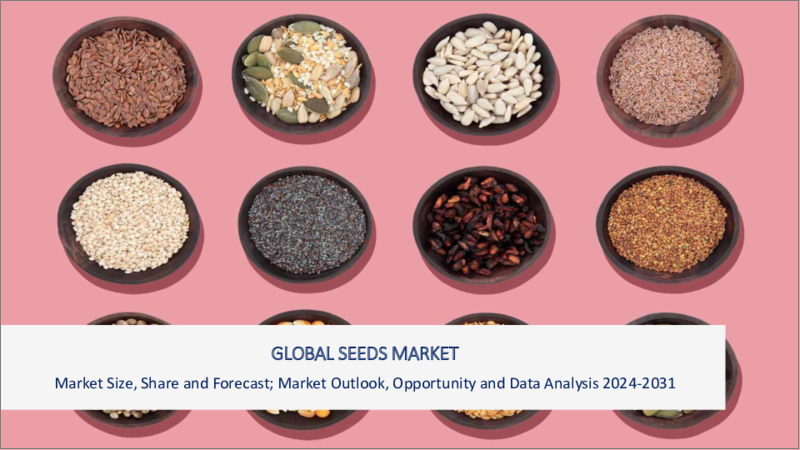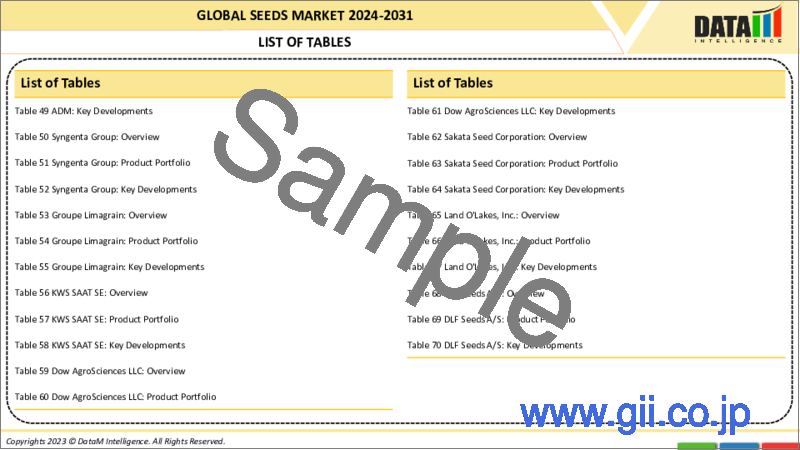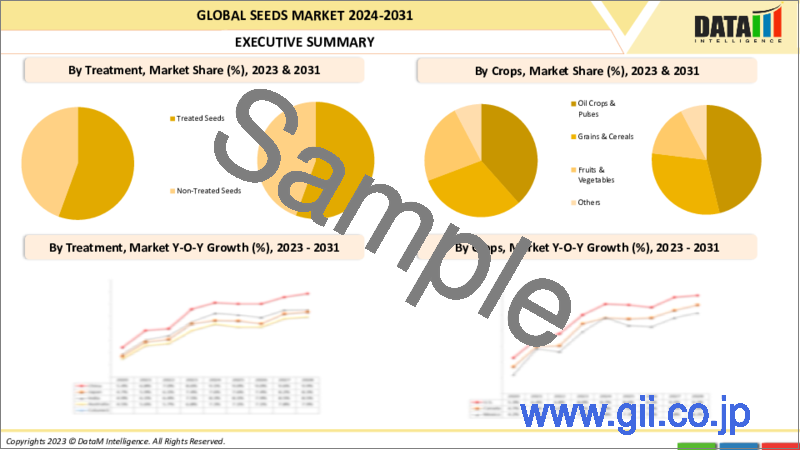|
|
市場調査レポート
商品コード
1297835
種子の世界市場- 2023年~2030年Global Seeds Market - 2023-2030 |
||||||
カスタマイズ可能
適宜更新あり
|
|||||||
| 種子の世界市場- 2023年~2030年 |
|
出版日: 2023年06月15日
発行: DataM Intelligence
ページ情報: 英文 195 Pages
納期: 即日から翌営業日
|
- 全表示
- 概要
- 目次
市場概要
種子の世界市場は、2022年に575億米ドルに達し、2030年には951億米ドルに達し、有利な成長が予測されています。予測期間2023-2030年のCAGRは6.5%と予測されます。
種子市場は、作物、果物、野菜、その他の植物用の多様な種子タイプを提供することにより、世界の食糧生産に重要な役割を果たす重要な分野です。大手企業や地域企業間の競争が激化する中、市場分析は市場規模、成長の可能性、新たな動向に関する貴重な考察を提供します。遺伝子組み換え(GM)種子の広範な採用は、害虫抵抗性や収量増加などの望ましい形質を提供するため、業界に革命をもたらしました。
同時に、より健康的で環境に優しい選択肢を求める消費者の嗜好により、有機種子や非遺伝子組み換え種子の需要も拡大しています。バイオテクノロジーと種子技術の進歩は、耐病性や耐乾燥性などの種子形質をさらに強化し、技術革新を促進して種子市場の成長に拍車をかけています。
市場力学
技術の進歩が種子市場の成長と市場シェア拡大を促進
最近の市場分析によると、バイオテクノロジーと種子技術における技術進歩が種子市場の主要促進要因として浮上しています。遺伝子組換え、精密育種、ハイブリッド品種や改良品種のイントロダクションが市場の成長を促進し、大手企業の市場シェアを拡大しています。
これらの進歩により、病害抵抗性、干ばつ耐性、栄養価の向上など、求められる形質を備えた種子が生み出され、研究開発に投資する企業にとって、種子市場のシェア拡大につながっています。
革新的な種子ソリューションを通じて農家や消費者の進化する需要に応えることで、これらの企業は競争の激しい市場での地位を確固たるものにしています。種子市場の分析では、業界情勢を形成し、高度な種子技術の採用を促進する上で、技術の進歩が極めて重要な役割を果たしていることが強調されています。
知的財産権保護が種子市場シェアとイノベーションに与える課題と影響
種子市場分析によると、知的財産権保護は種子市場において大きな抑制要因となっており、企業の市場シェアと収益性に影響を与えています。知的財産権の行使を確保することは、改良種子品種の開発に投資する企業にとって極めて重要です。無許可の種子保存、特許侵害、偽造種子などの課題が市場シェアを脅かしています。
知的財産権の保護と、農民が利用しやすく手頃な価格の種子を提供することのバランスを取ることは、市場シェアと技術革新に影響を与える複雑な課題です。市場分析では、健全な市場競争を促進し、革新的な種子ソリューションの採用を促進するために、これらの抑制要因に対処する必要性が強調されています。
COVID-19の影響分析
COVID-19の分析には、COVID前シナリオ、COVIDシナリオ、COVID後シナリオが含まれ、価格力学(COVID前シナリオと比較したパンデミック中およびパンデミック後の価格変動を含む)、需給スペクトラム(取引制限、封鎖、およびその後の問題による需要と供給のシフト)、政府の取り組み(政府機関による市場、セクター、産業を活性化させる取り組み)、メーカーの戦略的取り組み(COVID問題を緩和するためにメーカーが行ったことをここで取り上げる)が含まれます。
目次
第1章 調査手法と範囲
第2章 定義と概要
第3章 エグゼクティブサマリー
第4章 市場力学
- 影響を与える要因
- 促進要因
- 抑制要因
- 機会
- 影響分析
第5章 業界分析
- ポーターのファイブフォース分析
- サプライチェーン分析
- 価格分析
- 規制分析
第6章 COVID-19の分析
第7章 タイプ別
- 従来型
- 遺伝子組み換え
第8章 特性別
- 除草剤耐性
- 防虫剤耐性
- その他
第9章 治療別
- 処理種子
- 未処理種子
第10章 作物別
- 油料作物と豆類
- 穀物とシリアル
- 果物と野菜
- その他
第11章 地域別
- 北米
- 米国
- カナダ
- メキシコ
- 欧州
- ドイツ
- 英国
- フランス
- イタリア
- スペイン
- その他欧州
- 南米
- ブラジル
- アルゼンチン
- その他南米
- アジア太平洋
- 中国
- インド
- 日本
- オーストラリア
- その他アジア太平洋地域
- 中東とアフリカ
第12章 競合情勢
- 競合シナリオ
- 市場ポジショニング/シェア分析
- 合併と買収の分析
第13章 企業プロファイル
- Bayer CropScience AG
- 会社概要
- グレードのポートフォリオと説明
- 財務概要
- 主な発展
- Syngenta AG
- Corteva Agriscience
- BASF SE
- Groupe Limagrain
- KWS SAAT SE
- Land O'Lakes
- Sakata Seed Corporation
- Rijk Zwaan
- Takii &Co. Ltd
第14章 付録
Market Overview
The Global Seeds Market reached US$ 57.5 billion in 2022 and is projected to witness lucrative growth by reaching US$ 95.1 billion by 2030. The market is expected to exhibit a CAGR of 6.5% during the forecast period 2023-2030.
The seeds market is a crucial sector that plays a significant role in global food production by providing a diverse range of seed types for crops, fruits, vegetables, and other plants. With intense competition among major players and regional companies, market analysis offers valuable insights into the market's size, growth potential, and emerging trends. The widespread adoption of genetically modified (GM) seeds has revolutionized the industry, as they offer desirable traits such as pest resistance and increased yield.
Concurrently, the market also experiences a growing demand for organic and non-GM seeds, driven by consumer preferences for healthier and environmentally friendly options. Advancements in biotechnology and seed technology further enhance seed traits, including disease resistance and drought tolerance, fostering innovation and fueling growth within the seeds market.
Market Dynamics
Technological Advancements Drive Growth and Market Share Expansion in the Seeds Market
According to a recent market analysis, technological advancements in biotechnology and seed technology have emerged as key drivers of the seeds market. Genetic modification, precision breeding, and introduction of hybrid and improved varieties have fueled market growth and increased market share for major players.
These advancements have created seeds with sought-after traits like disease resistance, drought tolerance, and improved nutritional value, resulting in a larger seed market share for companies investing in research and development.
By meeting the evolving demands of farmers and consumers through innovative seed solutions, these companies have solidified their position in the highly competitive market. Seeds market analysis highlights the pivotal role of technological advancements in shaping the industry landscape and driving the adoption of advanced seed technologies.
Intellectual Property Protection Presents Challenges and Impact on Seeds Market Share and Innovation
According to seeds market analysis, intellectual property protection poses a significant restraint in the seeds market, affecting companies' market share and profitability. Ensuring the enforcement of intellectual property rights is crucial for companies investing in developing improved seed varieties. Challenges such as unauthorized seed saving, patent infringement, and counterfeit seeds threaten market share.
Striking a balance between protecting intellectual property rights and providing accessible and affordable seeds for farmers is a complex challenge impacting market share and innovation. The market analysis underscores the need to address these restraints to foster healthy market competition and drive the adoption of innovative seed solutions.
COVID-19 Impact Analysis
The COVID-19 Analysis includes Pre-COVID Scenario, COVID Scenario and Post-COVID Scenario along with Pricing Dynamics (Including pricing change during and post-pandemic comparing it with pre-COVID scenarios), Demand-Supply Spectrum (Shift in demand and supply owing to trading restrictions, lockdown and subsequent issues), Government Initiatives (Initiatives to revive market, sector or Industry by Government Bodies) and Manufacturers Strategic Initiatives (What manufacturers did to mitigate the COVID issues will be covered here).
Segment Analysis
The Global Seeds Market is segmented based on type, traits, treatment, crops, and region.
Yield Improvements and Growing Adoption drive the Genetically Modified Seeds Segment
The seeds market is segmented based on type, with two main categories: conventional and genetically modified (GM) sources. The Genetically Modified (GM) seed market holds a significant market share, driven by market analysis indicating its dominance in the industry. The market has experienced substantial growth, with increasing adoption and acceptance.
GM seed technology has led to significant yield improvements, with average yield increases ranging from 10% to 30% across various crops. Adoption rates vary by crop, with GM corn having a market penetration of over 90%. The GM seed market continues to evolve, driven by ongoing research and development investments, advancements in biotechnology, and the demand for sustainable agricultural practices.
Geographical Analysis
Asia-Pacific Seeds Market Dominates Global Industry with High Market Share, Driven by Rice and Corn Demand in the Region
The Global Seeds Market is segmented by region into North America, South America, Europe, Asia-Pacific, and Middle-east & America.
According to seeds market analysis, the Asia-Pacific seeds market holds a significant market share, accounting for approximately 40% of the global market. The region witnesses a growing adoption of hybrid seeds, particularly in major crops like rice, corn, and vegetables.
Additionally, the demand for genetically modified (GM) seeds is increasing, driven by the need for higher crop yields and improved pest resistance. The Asia-Pacific seeds market presents opportunities for companies to leverage the region's large agricultural sector and address the evolving needs of farmers.
Competitive Landscape
The major global players include: Bayer CropScience AG, Syngenta AG, Corteva Agriscience, BASF SE, Groupe Limagrain, KWS SAAT SE, Land O'Lakes, Sakata Seed Corporation, Rijk Zwaan and Takii & Co. Ltd.
Why Purchase the Report?
- To visualize the Global Seeds Market segmentation based on type, traits, treatment, crops and region, as well as understand key commercial assets and players.
- Identify commercial opportunities by analyzing trends and co-development.
- Excel data sheet with numerous data points of seeds market-level with all segments.
- The PDF report includes a comprehensive analysis after exhaustive qualitative interviews and an in-depth study.
- Product mapping available as Excel consisting of key products of all the major players.
The Global Seeds Market Report Would Provide Approximately 69 Tables, 66 Figures And 195 pages.
Target Audience 2023
- Manufacturers/ Buyers
- Industry Investors/Investment Bankers
- Research Professionals
- Emerging Companies
Table of Contents
1. Methodology and Scope
- 1.1. Research Methodology
- 1.2. Research Objective and Scope of the Report
2. Definition and Overview
3. Executive Summary
- 3.1. Snippet by Type
- 3.2. Snippet by Traits
- 3.3. Snippet by Treatment
- 3.4. Snippet by Crops
- 3.5. Snippet by Region
4. Dynamics
- 4.1. Impacting Factors
- 4.1.1. Drivers
- 4.1.2. Restraints
- 4.1.3. Opportunity
- 4.1.4. Impact Analysis
5. Industry Analysis
- 5.1. Porter's Five Force Analysis
- 5.2. Supply Chain Analysis
- 5.3. Pricing Analysis
- 5.4. Regulatory Analysis
6. COVID-19 Analysis
- 6.1. Analysis of COVID-19
- 6.1.1. Scenario Before COVID-19
- 6.1.2. Scenario During COVID-19
- 6.1.3. Post COVID-19 and Future Scenario
- 6.2. Pricing Dynamics Amid COVID-19
- 6.3. Demand-Supply Spectrum
- 6.4. Government Initiatives Related to the Market During Pandemic
- 6.5. Manufacturers Strategic Initiatives
- 6.6. Conclusion
7. By Type
- 7.1. Introduction
- 7.1.1. Market Size Analysis and Y-o-Y Growth Analysis (%), By Type
- 7.1.2. Market Attractiveness Index, By Type
- 7.2. Conventional*
- 7.2.1. Introduction
- 7.2.2. Market Size Analysis and Y-o-Y Growth Analysis (%)
- 7.3. Genetically Modified
8. By Traits
- 8.1. Introduction
- 8.1.1. Market Size Analysis and Y-o-Y Growth Analysis (%), By Traits
- 8.1.2. Market Attractiveness Index, By Traits
- 8.2. Herbicide-Tolerant*
- 8.2.1. Introduction
- 8.2.2. Market Size Analysis and Y-o-Y Growth Analysis (%)
- 8.3. Insecticide-Resistant
- 8.4. Others
9. By Treatment
- 9.1. Introduction
- 9.1.1. Market Size Analysis and Y-o-Y Growth Analysis (%), By Treatment
- 9.1.2. Market Attractiveness Index, By Treatment
- 9.2. Treated Seeds*
- 9.2.1. Introduction
- 9.2.2. Market Size Analysis and Y-o-Y Growth Analysis (%)
- 9.3. Non-Treated Seeds
10. By Crops
- 10.1. Introduction
- 10.1.1. Market Size Analysis and Y-o-Y Growth Analysis (%), By Crops
- 10.1.2. Market Attractiveness Index, By Crops
- 10.2. Oil Crops & Pulses*
- 10.2.1. Introduction
- 10.2.2. Market Size Analysis and Y-o-Y Growth Analysis (%)
- 10.3. Grains & Cereals
- 10.4. Fruits & Vegetables
- 10.5. Others
11. By Region
- 11.1. Introduction
- 11.1.1. Market Size Analysis and Y-o-Y Growth Analysis (%), By Region
- 11.1.2. Market Attractiveness Index, By Region
- 11.2. North America
- 11.2.1. Introduction
- 11.2.2. Key Region-Specific Dynamics
- 11.2.3. Market Size Analysis and Y-o-Y Growth Analysis (%), By Type
- 11.2.4. Market Size Analysis and Y-o-Y Growth Analysis (%), By Traits
- 11.2.5. Market Size Analysis and Y-o-Y Growth Analysis (%), By Treatment
- 11.2.6. Market Size Analysis and Y-o-Y Growth Analysis (%), By Crops
- 11.2.7. Market Size Analysis and Y-o-Y Growth Analysis (%), By Country
- 11.2.7.1. The U.S.
- 11.2.7.2. Canada
- 11.2.7.3. Mexico
- 11.3. Europe
- 11.3.1. Introduction
- 11.3.2. Key Region-Specific Dynamics
- 11.3.3. Market Size Analysis and Y-o-Y Growth Analysis (%), By Type
- 11.3.4. Market Size Analysis and Y-o-Y Growth Analysis (%), By Traits
- 11.3.5. Market Size Analysis and Y-o-Y Growth Analysis (%), By Treatment
- 11.3.6. Market Size Analysis and Y-o-Y Growth Analysis (%), By Crops
- 11.3.7. Market Size Analysis and Y-o-Y Growth Analysis (%), By Country
- 11.3.7.1. Germany
- 11.3.7.2. The U.K
- 11.3.7.3. France
- 11.3.7.4. Italy
- 11.3.7.5. Spain
- 11.3.7.6. Rest of Europe
- 11.4. South America
- 11.4.1. Introduction
- 11.4.2. Key Region-Specific Dynamics
- 11.4.3. Market Size Analysis and Y-o-Y Growth Analysis (%), By Type
- 11.4.4. Market Size Analysis and Y-o-Y Growth Analysis (%), By Traits
- 11.4.5. Market Size Analysis and Y-o-Y Growth Analysis (%), By Treatment
- 11.4.6. Market Size Analysis and Y-o-Y Growth Analysis (%), By Crops
- 11.4.7. Market Size Analysis and Y-o-Y Growth Analysis (%), By Country
- 11.4.7.1. Brazil
- 11.4.7.2. Argentina
- 11.4.7.3. Rest of South America
- 11.5. Asia-Pacific
- 11.5.1. Introduction
- 11.5.2. Key Region-Specific Dynamics
- 11.5.3. Market Size Analysis and Y-o-Y Growth Analysis (%), By Type
- 11.5.4. Market Size Analysis and Y-o-Y Growth Analysis (%), By Traits
- 11.5.5. Market Size Analysis and Y-o-Y Growth Analysis (%), By Treatment
- 11.5.6. Market Size Analysis and Y-o-Y Growth Analysis (%), By Crops
- 11.5.7. Market Size Analysis and Y-o-Y Growth Analysis (%), By Country
- 11.5.7.1. China
- 11.5.7.2. India
- 11.5.7.3. Japan
- 11.5.7.4. Australia
- 11.5.7.5. Rest of Asia-Pacific
- 11.6. Middle East and Africa
- 11.6.1. Introduction
- 11.6.2. Key Region-Specific Dynamics
- 11.6.3. Market Size Analysis and Y-o-Y Growth Analysis (%), By Type
- 11.6.4. Market Size Analysis and Y-o-Y Growth Analysis (%), By Traits
- 11.6.5. Market Size Analysis and Y-o-Y Growth Analysis (%), By Treatment
- 11.6.6. Market Size Analysis and Y-o-Y Growth Analysis (%), By Crops
12. Competitive Landscape
- 12.1. Competitive Scenario
- 12.2. Market Positioning/Share Analysis
- 12.3. Mergers and Acquisitions Analysis
13. Company Profiles
- 13.1. Bayer CropScience AG
- 13.1.1. Company Overview
- 13.1.2. Grade Portfolio and Description
- 13.1.3. Financial Overview
- 13.1.4. Key Developments
- 13.2. Syngenta AG
- 13.3. Corteva Agriscience
- 13.4. BASF SE
- 13.5. Groupe Limagrain
- 13.6. KWS SAAT SE
- 13.7. Land O'Lakes
- 13.8. Sakata Seed Corporation
- 13.9. Rijk Zwaan
- 13.10. Takii & Co. Ltd
LIST NOT EXHAUSTIVE
14. Appendix
- 14.1. About Us and Services
- 14.2. Contact Us





